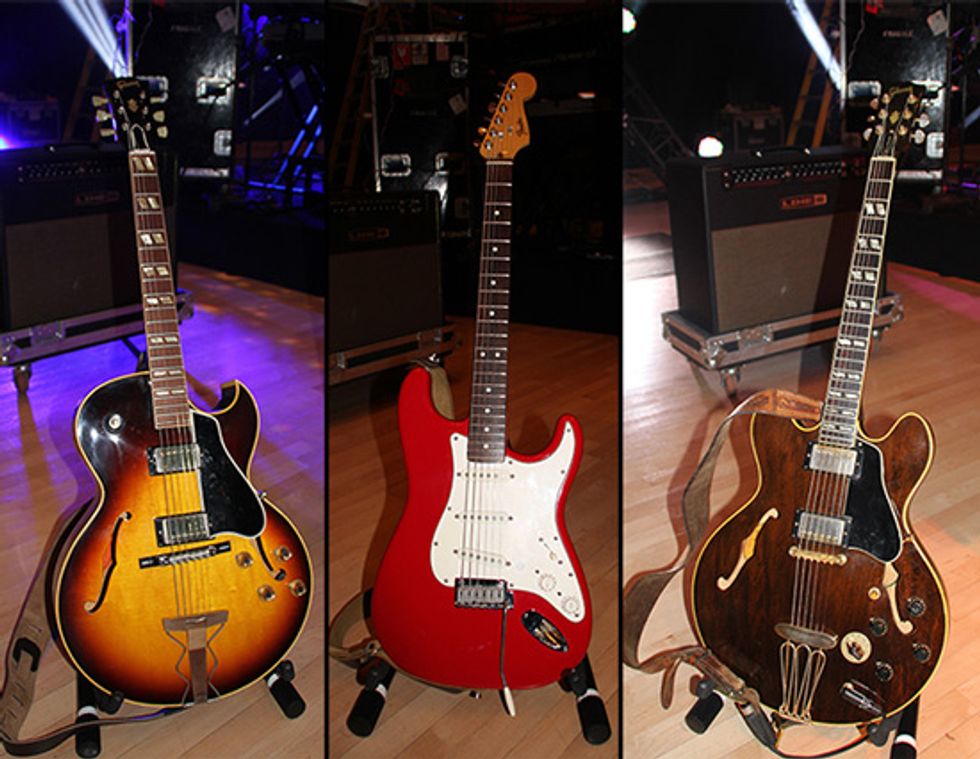Premier Guitar's Shawn Hammond is on location in Omaha, Nebraska, where he catches up with Yes' Chris Squire and Steve Howe to check out their vintage gear, including old Rickenbackers, Gibsons, Fenders, and more.
Guitars
Steve Howe’s main guitar for the current Yes tour—on which the band is
playing The Yes Album, Close to the Edge, and Going for the One albums
in their entirety—is his No. 2 1964 Gibson ES-175 (which he only uses in
the U.S.). For “Parallels” off of Going for the One, he uses a mid-’80s
Fender Stratocaster modified to use just one volume and tone knob (the
original volume-pot position is vacant). And for Close to the Edge
tracks he uses this 1970 Gibson ES-345 with stereo wiring and a Gibson
Byrdland tailpiece.
Also on tour is a 1955 Fender Telecaster with added neck humbucker and a 3-way upper-bout switch and individual string saddles (also for “Awaken”) and Portuguese 12-string acoustic tuned E–B–E–B–E–Ab (for “I’ve Seen All Good People” and “Wonderous Stories”). Not pictured is a Gibson Steve Howe signature ES-175 with middle humbucker and ES-5 Switchmaster-style switching (functions as a standby to No. 2 and for Fragile tunes that originally featured a Gibson ES-5 Switchmaster), double-neck Fender steel guitar with one neck in E-major tuning and the 6th string tuned to the same pitch as the 4th and another neck in E9 tuning (used on “Going for the One,” “Awaken,” and “And You and I”), 1956 Gibson Les Paul Custom “Black Beauty” (for “Turn of the Century”), and 24-fret Steinberger 12-string with EMG SA single-coils (for “Awaken”). Martin MC-38 Steve Howe signature model (for “Clap” and “Turn of the Century”)
Howe also uses a Line 6 Variax 600 (for Danelectro Sitar, Guild 12-string, and Martin 0-18 sounds).
Chris Squire brought a number of basses on this tour, including a Kid’s Guitars replica of a Bob Wal triple-neck bass (left), which he uses on “Awaken” from Going for the One. Its 6-string top neck is tuned A–D–G (with octave strings for each), while the middle neck is fretted, and the bottom neck is fretless. In the middle is Squire’s legendary 1964 Rickenbacker 4001, which has powered “Roundabout” and countless other Yes classics. The 8-string Ranney (right)—which Squire plays on “Going for the One”—has a 5-piece body and active electronics.
He also travels with a ’70s custom Jim Mouradian green bass with J-style pickups and dual volumes and tones for each, spare Rickenbacker 4001 with custom graphics from Squire’s 1975 Fish out of Water solo album, an early-’70s Fender Jazz bass (played on “Parallels” from Going for the One), and, not pictured, a custom Tobias 5-string normally tuned to B–E –A–D but tuned to C–E–A–D for “Turn of the Century,”
Amps
Squire has relied on the same two vintage Marshall heads for decades, though his main one—the 1965 JMP on bottom head—has never broken down so he’s rarely used the top one. (Wondering about those mods? For the 1978 Tormato tour, it was customized to work with a separate power amp feeding two custom 6x12 cabinets in which each driver was angled to fire in a different direction.)
Squire blends his Marshall signal with one from a pair of Ampeg SVT-2PRO heads (bottom). An SWR Bass 350 head (middle) amplifies the Moog Taurus bass-pedal tones generated by his E-Mu ESI 2000 (second from top).
Though he long famed for using two Fender Twin Reverbs, Howe is now relying on a Line 6 DT50 amp, which works in tandem with his painstakingly programmed Line 6 PODHD500.
Effects
Howe and his tech have spent many hours programming true-to-the-record tones into his Line 6 PODHD500—his only effects device. He uses the Morley A/B pedal to switch between acoustic and electric guitars.
Squire’s pedal drawer features an ancient vibrato pedal custom-built for him in the ’60s (top middle). Also on the top shelf are a 1960s Maestro Bass Brassmaster fuzz (front left), a TC Electronic Chorus+ (right), and a rarely used Boss OC-3 Super-Octave (back left). The bottom drawer is stocked with a TC Electronic
















![Rig Rundown: Russian Circles’ Mike Sullivan [2025]](https://www.premierguitar.com/media-library/youtube.jpg?id=62303631&width=1245&height=700&quality=70&coordinates=0%2C0%2C0%2C0)

















